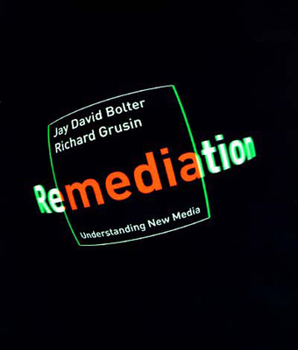Remediation: Understanding New Media
Select Format
Select Condition 
Book Overview
A new framework for considering how all media constantly borrow from and refashion other media. Media critics remain captivated by the modernist myth of the new: they assume that digital technologies such as the World Wide Web, virtual reality, and computer graphics must divorce themselves from earlier media for a new set of aesthetic and cultural principles. In this richly illustrated study, Jay David Bolter and Richard Grusin offer a theory...
Format:Paperback
Language:English
ISBN:0262522799
ISBN13:9780262522793
Release Date:February 2000
Publisher:MIT Press
Length:312 Pages
Weight:1.20 lbs.
Dimensions:0.6" x 7.0" x 8.9"
Age Range:18 years and up
Grade Range:Postsecondary and higher
Customer Reviews
2 ratings
This book will change the way you watch CNN
Published by Thriftbooks.com User , 23 years ago
In Remediation, Jay David Bolter and Richard Grusin analyze new technologies and their implications for American society. Although the book emphasizes the ways in which new media can be conceived in terms of recent literary and cultural theory, the theoretical discussions do not pervade the work. Therefore, the book can still be quite useful to those who don't wish to delve too deeply into theory. In fact, Bolter and Grusin acknowledge the different emphases of the book's chapters in their introduction and offer readers a guide to help them make the most of their experience with the book, with respect to the readers' goals. The three sections of the book discuss the authors' theory of remediation, the place of new media in American society, and the place of the Self within the context of new media.In the first section of the book, Bolter and Grusin offer the notion of "remediation" as a way of thinking about new media. What they term "remediation" is "the formal logic by which new media technologies refashion prior media forms" (273). Bolter and Grusin attempt to contextualize their theories about new media within the framework of modern preoccupations with what they term "immediacy" and "hypermediacy." The desire for immediacy is a desire for a transparency in media that obliterates or lessens the perception of the media themselves in the viewer's mind. The reality of hypermediacy is the preoccupation with media itself and a hyper-awareness of the media through which our information comes. Bolter and Grusin place the logic of remediation within the context of our historical preoccupation with these trends. The new media discussed are primarily the visual: computer games, digital photography, photorealistic graphics, digital art, film, Virtual Reality, mediated spaces, television, and the World Wide Web. Discussing each of these media in great detail, the authors devote the second section of the book to demonstrating the way that the idea of remediation plays itself out in each. Bolter and Grusin examine how each new medium refashions older media and how they are often refashioned themselves. For example, they show that animated computer graphics draw upon the tradition of film and that film is now starting to draw upon the new offerings of computer graphics. They cite as their evidence a film such as Toy Story. Another example they point out is the remediation that occurs between television and the Internet. The Internet uses patterns established by television in order to determine how to appeal to viewers, and television uses new strategies of windowing images with the scrolling tickertapes and texts it has borrowed from Internet styles. Within the remediations that both new and old media undergo, Bolter and Grusin demonstrate how the twin desires for immediacy and hypermediacy are at work.The final section on the Self attempts to discuss how the presence of the new media in our society affects individuals' perceptions of thei
Remediating without knowing it!
Published by Thriftbooks.com User , 23 years ago
This book was most enligthening, it explained in a very structured form, what it is we were doing when creating content for new medias. As Moliere said, "doing prose without knowing it", I have used my newly acquired epistemology of remediation extensively to better explain to our young designers what it is they were doing when "re-mediating" clients'content for a new media application, be it Web, Multimedia apps or art-tech.The authors are themselves professors/researchers an use a very didactical stream of thoughts which has been exceedingly usefull to me, to better convey concepts for which I had a feeling, but nowhere near the "theory of remediation" that the authors convey.As an art/tech buff, who happens to earn a living with technical content remediation and hard core applications programming, the book reconciled me with a new perpesctive on the similarities between these activities. Grusin and Bolter are challenging us to excellence in remediation whatever the final purpose.The most important concept that the authors brought to me, was that more and better remediation has often nothing to do with more technology, and much more to do with better and more effective (or intelligent) ways to communicate.In my view this book is a must reading, and a reference book for anyone producing content with a certain degree of awareness. If you believe that the new media demand a "different" attitude,this is a textbook for you.






